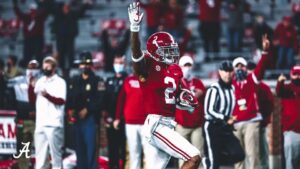By David Mullen
Major League Baseball and Major League Soccer have begun their seasons. The NBA and NHL are moving toward the playoffs. NASCAR is running. Major golf tournaments are in full swing. The Kentucky Derby is heading to post time. Even the WWF is getting the cage ready for a “Backlash” and an “Invasion.” But for many, the biggest circle on the sports calendar is coming up.

Photo courtesy of the Official Facebook Page of Pat Surtain, aka “PS2”
The 2021 NFL Draft will soon blow into beautiful downtown Cleveland. For football nerds, the winds of change coming off the now fire-proof Lake Erie is a trip to Xanadu. For everyone else, it is a prompt to search the on-screen TV guide.
The NFL, never missing an opportunity to turn something mundane into a full-blown spectacle, will air all seven rounds of the human stock show throughout three days across two major cable sports networks.
Look back at the first Super Bowl halftime before the NFL entertaining arm got hold of it. The presentation was 15 minutes of commentary and Al Hirt blowing his horn, giving fans a chance to grab some “Java.” The “2021 Pepsi Super Bowl LV Halftime Show” was 24 minutes long, but seemed to last “The Weeknd.”
And now the NFL has formulated the NFL Draft into Super Bowl Zero Sugar.
Choosing first overall guarantees nothing except for a big contract for the incoming player and a little drama for fans of the team with the worst record. Throughout the past nine seasons, top picks included quarterbacks Andrew Luck, who took an early retirement, Jared Goff, who the Los Angeles Rams have already given up on and traded, and Jameis Winston, who will be asked to renew his career in New Orleans after failure in Tampa Bay.
The first overall pick in 2014, defensive end Jadeveon Clowney, is on his fourth team. It is too early to judge the success of quarterbacks Baker Mayfield, Kyler Murray and Joe Burrow, although they have the support of their teams … for now.
The point is that teams and fans put too much emphasis on draft picks. Can a group of quality draft picks turn a franchise around? Certainly, as it did with the Pittsburgh Steelers of the 1970s and the Dallas Cowboys in the late 80s and early 90s. But the key is multiple picks — not just one — and adding key free agents to fill roles.
The first NFL draft was in 1936. Technology consisted of a blackboard and chalk in a smoke-filled room at the Ritz-Carlton in Philadelphia. Once the NFL had 20-round drafts, as it was the primary way that clubs filled a roster. If the NFL Draft were 20 rounds today, it would become an ABC miniseries.
The draft reached its zenith when the American Football League (AFL) began as a competitor to the stodgy NFL. The first three AFL drafts in the early 1960s were held at the Dallas Statler Hotel.
Leagues competed for college stars like Billy Cannon, Jim Otto, Lance Alworth and Joe Namath, which the AFL snagged. The two leagues agreed to merge by 1970 with the first “common draft” held in 1967.
The Denver Broncos, Baltimore Ravens and Seattle Seahawks have never had a first overall pick. Since 1998 (1997 season), those three teams have won six Super Bowl titles.
Dallas has the tenth overall pick in the NFL Draft in 2021, six picks in the first four rounds and 10 picks overall. Jerry “I am the owner of the Dallas Cowboys” Jones has been known to get an itchy trigger finger on Draft day. He loves to orchestrate trades, so you never really know where the Cowboys will select.
At pick 10, theoretically there are nine players better. However, early draft picks are almost always chosen for a need and not because they are the best athletes. Three quarterbacks could be chosen with the top three picks. Trevor Lawrence of Clemson is a lock as the first pick by the Jacksonville Jaguars. He is already on social media reaching out to the northern Florida community.
The New York Jets seem to be gravitating toward QB Zach Wilson from BYU with the second pick, meaning it’s between Ohio State QB Justin Fields, Alabama QB Mac Jones or even North Dakota State’s QB Trey Lance to San Francisco at three. And then the posturing begins.
Assuming that the Cowboys stay at No. 10, it is almost certain that they will select Alabama cornerback Patrick Surtain II. His credentials are impressive. He is 6-foot-2 and 202 lbs., the prototypical size for a defensive back. He was a unanimous All-American, a National Champion, and his father played cornerback in the NFL with the Miami Dolphins and Kansas City Chiefs.
The Cowboys are desperate at cornerback, although rarely does a DB step in and find quality minutes right away. In Surtain II’s case, he will have the opportunity to start immediately. Even at 44, his father could probably start in Dallas’ defensive backfield.
If Surtain II is the 10th pick in the NFL draft, he will be in good company. Hall-Of-Famers Marcus Allen, Rod Woodson and Jerome Bettis were all drafted 10th, as was former NFL Defensive Player of the Year Terrell Suggs. The man with the golden arm and platinum contract, Kansas City quarterback Patrick Mahomes, was also a 10th overall pick.
But then, the enticing theory of the “best available athlete” comes into focus. What if Fields, Florida TE Kyle Pitts, LSU WR Ja’Marr Chase or Alabama WR and Heisman Trophy winner DeVonta Smith are still on the board?
Jones likes to hob-nob with super talent, and while those four don’t address a Cowboys need, they sure are tempting to dream about. That is why people watch the NFL Draft.
The three-day made-for-TV comedy/drama begins on Thursday, April 29. Whether there is a surprise ending remains to be written. Expect many plotlines, just like the NFL scripted it.
